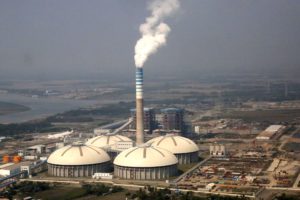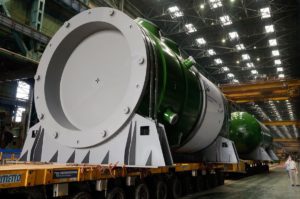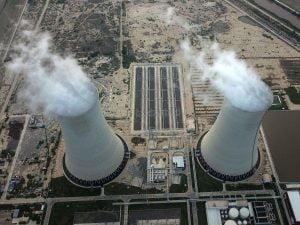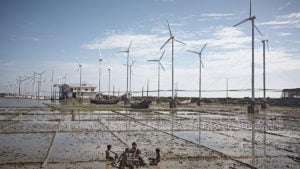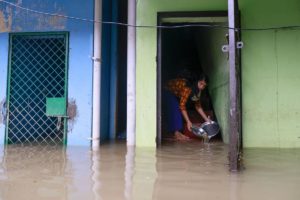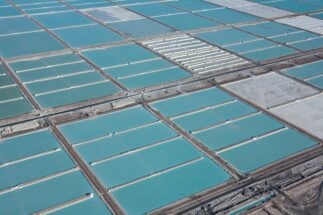Ahead of the UN climate summit in Glasgow last year, Bangladesh pledged to produce 40% of its electricity from renewables by 2041. To meet this target, the country is shifting investments away from coal, oil and gas. The role of Chinese investments in Bangladesh in driving this transition will be key, experts have told The Third Pole.
The energy sector currently accounts for about 55% of Bangladesh’s greenhouse gas emissions, followed by agriculture, forest and land use, waste and industrial processes. By 2030, the UN expects energy to account for more than 76% of Bangladesh’s emissions.
Nasrul Hamid, minister for power, energy and mineral resources, told The Third Pole: “To produce 40% of [electricity] from renewable sources, we need huge investment. We need USD 80 to 100 billion [between 2030 and 2050]. We have started negotiating with China, Japan, the Asian Development Bank and the World Bank.”
Siddique Zobayer, a sustainable energy expert at the Asian Development Bank, told The Third Pole: “China, currently Bangladesh’s largest trading partner, is investing in most of the renewable projects.”
New master plan to put Bangladesh on a clean energy path
To put Bangladesh on the path to a low-carbon future while ensuring energy security, Hamid said, the government is finalising an Integrated Energy-Power Sector Master Plan (IEPSMP) to replace its Power Sector Master Plan (PSMP). The government aims to finalise the plan by the end of this year, according to an official at the energy ministry who spoke on condition of anonymity.
Bangladesh currently has an installed power generation capacity of 22,482 MW. Gas accounts for 51% of this, followed by heavy fuel oil (28%), coal (8%), and high-speed diesel (6%). Hydropower and solar account for only 1% each.
Bangladesh’s plan to generate 40% of its electricity from renewables by 2050 is divided into three phases: 2023 to 2030, 2030 to 2040, and 2040 to 2050. Mohammad Hossain, director-general of Power Cell (the part of the Ministry of Power, Energy and Mineral Resources responsible for reforming the power sector), told The Third Pole that in the first phase the proportion of electricity generated from gas will be 35% – a fall from the 70% target for 2020 set by the 2010 and 2016 PSMPs. Renewables will increase from about 2% to 10%.
The plan is a significant departure from the 2010 iteration of the Power Sector Master Plan, which planned for coal to provide 50% of Bangladesh’s energy by 2030. Instead, under the new plan, coal will rise from 5% in 2020 to 10% by 2030.
The country has had iterations of the PSMP over the last four decades, always with cost of energy as the main consideration. Now, says Hossain, the IEPSMP will focus on energy security, economic efficiency, the environment, and safety. An official who spoke on the condition of anonymity described it as the “3E+S approach”.
The 2016 PSMP had a target of generating 33,250 MW by 2030 from imported coal – 35% of the total generation planned. To achieve this, the government launched 13 coal-based power projects that increased the use of coal in power production by 63 times, compared with the previous PSMP.
Environmentalists warned that if the government were to generate power from all 13 plants, Bangladesh would emit an additional 115 million tonnes of carbon dioxide every year.
Marking the first major departure in energy policy, in June 2021 the government scrapped 10 coal-fired power plant projects with a production capacity of 8,451 MW.
On the new energy plan, minister Hamid said: “We are reviewing the PSMP for two reasons. First, we need to keep our promise made at the UN [climate conference]. Second, we need fuel diversification as the indigenous sources of fuel [gas] are depleting.”
Almost 90% of energy projects in the pipeline are funded by ChinaSiddique Zobayer, Asian Development Bank
Energy demand is growing rapidly in Bangladesh as it increases its industrial capacity, especially in textiles and pharmaceuticals. The UN expects Bangladesh to move from the Least Developed Countries group to developing country status by 2026. The government has a target of reaching developed country status by 2041.
Analysts have said this will only happen if GDP grows by 9% every year for the next 25 years. For that, energy supply will have to grow even more rapidly. Minister Hamid told The Third Pole: “To attain the targeted GDP growth, we need to produce huge electricity.”
Sixty per cent of funding for the country’s energy projects has come via the Bangladesh government, which has got much of this money from organisations like the World Bank, Asian Development Bank, Japan International Cooperation Agency and US Agency for International Development. The other 40% comes from private investors, including India’s Adani group, foreign direct investors and local companies.
Chinese investment is key to Bangladesh’s ambitions
“Almost 90% of the [energy] projects in the pipeline are funded by China,” said the ADB’s Zobayer. “If they turn their big coal power projects to renewables, then we can be in a better position to achieve our 2041 target.”
Data from September 2021 showed that China had invested USD 450 million in coal power plants in Bangladesh. Two such power plants with a combined capacity of 1,845 MW, backed by Chinese companies, are already in operation, according to the Bangladesh Working Group on External Debt.
But in September 2021, Chinese president Xi Jinping announced that China would not build any more coal-fired power plants abroad.
Mohammad Hossain told the The Third Pole that back in February 2021, the Chinese embassy in Dhaka wrote to the Bangladesh finance ministry saying “the Chinese side shall no longer consider projects with high pollution and high energy consumption, such as coal mining [and] coal-fired power stations.” The letter suggested that Bangladesh “select new projects”. Hossain said Bangladesh responded by requesting that five projects worth USD 3.6 billion in Chinese loans be replaced. Three of these projects were coal-fired power plants. The memorandums of understanding for these projects had already been signed.
China’s announcement has some long-term impacts as they are the biggest player hereMohammad Hossain, Power Cell
Hossain said: “China’s announcement has some long-term impacts as they are the biggest player here.” However, he pointed out that five coal-fired power plants that are already being built by Chinese state-owned corporations are going ahead – in Banshkhali by SEPCOIII, Barishal by Power China, Payra by China National Machinery Import and Export Corporation (CMC), Patuakhali by Norinco International Power and Saidpur by Dongsang Electric International Corporation (DEC). They have a total capacity to generate 4,460 MW.
“We did not cancel these Chinese-funded projects as they [Chinese companies] haven’t said anything in this regard,” said Hossain. “But we are in a discomfort zone.”
Now, China’s Belt and Road Initiative energy investment package offers an opportunity for a transition from coal to renewable energy. In 2020, Bangladesh’s North-West Power Generation Company Limited and Chinese engineering contractor National Machinery Import and Export Corporation (CMC) formed a joint venture for renewable energy. It plans to build 450 MW of new solar capacity and a 50 MW wind farm, Hossain of Power Cell said.
These projects will run under the public-private partnership model. The government will provide land for these projects, while China will invest an estimated USD 500 million to develop them.
Zobayer, from the ADB, told The Third Pole: “Green development guidance for BRI projects are now open for countries like Bangladesh as China has shifted its energy development strategy. The Asian Development Bank and Asian Infrastructure Investment Bank have both signalled that they will no longer support coal. In addition, the region’s biggest coal financiers, Japan and South Korea, have started to use regulation to curtail their support for overseas coal projects under mounting international pressure. So, we need to shift from coal to renewables.”
